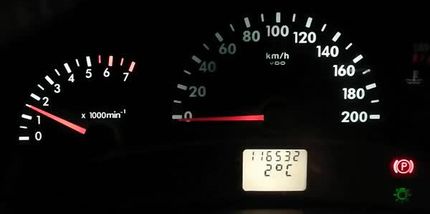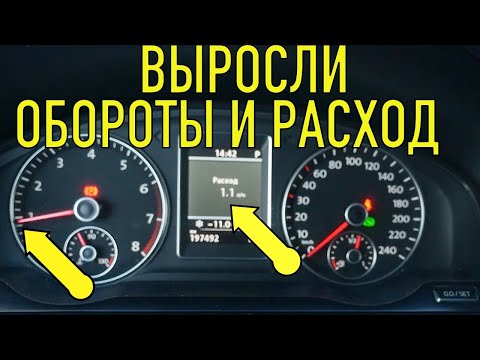
High rpm cold
Content
High rpm cold can appear both in the normal mode of operation of the internal combustion engine, and when some of its sensors fail. In the latter case, on injection internal combustion engines, it is necessary to check the idle speed controller, throttle position sensor, coolant temperature sensor, and intake manifold. For carbureted gasoline engines, you also need to check the idle speed adjustment, the operation of the air damper, and the carburetor chamber.
The operation of the internal combustion engine at warm-up speeds

In general, high revs on a cold ICE in cold weather are normal. However, their meaning and the duration of the motor in this mode may be different. So, if you start the internal combustion engine at a temperature, for example, from +20 ° C and above, then the time when the idle speed value returns to that specified in the manual (approximately 600 ... 800 rpm) will be several seconds (2 ... 5 seconds in summer time and about 5 ... 10 seconds in winter). If this does not happen, then there is a breakdown, and additional checks and appropriate repair measures must be performed.
High revs when starting an internal combustion engine on a cold one are necessary for two reasons. The first is the gradual warming up of engine oil, and, accordingly, a decrease in its viscosity. The second is the gradual heating of the internal combustion engine to the normal operating temperature of the coolant, which is about + 80 ° С ... + 90 ° С. This is achieved by increasing the amount of fuel burned.
Therefore, the appearance of high speeds when starting the internal combustion engine to a cold one is normal. However, one must take into account their value and the time after which they return to the value corresponding to idling. The values of revolutions and time are indicated in the technical documentation for a particular car. If the speed and / or return time is too high or, on the contrary, low, then you need to look for the cause of the breakdown.
The reason for the high idle speed of the internal combustion engine
There are as many as fourteen reasons why a cold ICE has high speeds for a long time after starting. namely:
- Throttle valve. Air can enter the internal combustion engine through a raised throttle valve when, for example, its drive cable is tightened (if it is provided for by the design). In this case, at idle speed, more than the required amount of air enters the internal combustion engine, which, in fact, leads to high speeds during a cold start. Another option is to use a hard mat on the floor that can support the gas pedal without the driver pressing it. In this case, the speed will also be increased, not only when the engine is cold, but also when the engine is warm. The throttle valve may not close completely due to the fact that it is very dirty with carbon deposits. In this case, he simply will not allow it to fit tightly.
- Idle channel. All ICE carburetor models have an air duct that bypasses the throttle valve. The cross section of the channel is regulated by a special adjusting bolt. Accordingly, if the channel cross section is incorrectly adjusted, more than the required amount of air will pass through the idle channel, which will lead to the fact that the internal combustion engine is running at high speeds when cold. True, such a situation can be “hot”.
- Air channel to maintain high speeds of a cold internal combustion engine. This channel is closed using a rod or valve. Accordingly, the position of the rod or the angle of the damper depends on the temperature of the antifreeze in the cooling system (that is, essentially, the temperature of the internal combustion engine). When the internal combustion engine is cold, the channel is completely open, and accordingly, a large amount of air flows through it, providing increased speed when cold. As the internal combustion engine warms up, the channel closes. If the rod or damper does not completely block the flow of additional air, this will lead to increased engine speed.
- Intake manifold air duct. In different designs of the ICE, it is blocked by a servo ICE, a pulsed electric ICE, a solenoid valve or a solenoid with a pulse control. If these elements fail, the air channel will not be blocked properly, and accordingly, a large amount of air will pass through it into the intake manifold.
- intake manifold pipes. Often, excess air enters the system due to depressurization of the nozzles or their attachment points. This can usually be determined by the whistle coming from there.
- For some cars, such as Toyota, the design of the internal combustion engine provides for the use electric engine for forced increase in idle speed. Their models and management methods differ, however, all have a separate management system. Therefore, the problem of high idling speed can be associated either with the specified electric engine or with its control system.
- Throttle position sensor (TPS or TPS). There are four types of them, however, their basic task is to transmit information to the ICE control unit about the position of the damper at a particular moment in time. Accordingly, in the event of a breakdown of the TPS, the ECU goes into emergency mode and gives the command to supply the maximum amount of air. This leads to the formation of a lean air-fuel mixture, as well as high idle speeds of the internal combustion engine. Often, in this case, in the operating mode, the revolutions can “float”. RPMs can also increase when throttle settings are reset.
- Idle speed regulator. These devices come in three types - solenoid, stepper and rotary. Usually the causes of failure of the IAC are damage to its guide needle or damage to its electrical contacts.
- Mass air flow sensor (DMRV). In the event of a partial or complete failure of this element, incorrect information about the amount of air supplied to the internal combustion engine will also be supplied to the control unit. Accordingly, a situation may arise when the ECU decides to open the throttle more or fully to increase the intake of air. This will naturally lead to an increase in engine speed. With unstable operation of the DMRV, the revolutions can not only be increased “to cold”, but also be unstable in other engine operating modes.
- Intake air temperature sensor (DTVV, or IAT). The situation is similar to other sensors. When incorrect information is received from it to the control unit, the ECU cannot issue commands for the formation of optimal revolutions and the creation of a combustible-air mixture. Therefore, it is likely that if it breaks, increased idle speeds may appear.
- Coolant temperature sensor. When it fails, information will be sent to the computer (or generated automatically in it) that the antifreeze or antifreeze has also not warmed up enough, so the internal combustion engine will run at high speed in order to supposedly warm up to operating temperature.
- Reduced water pump efficiency. If for some reason its performance has decreased (it has begun to pump an insufficient amount of coolant), for example, the impeller has worn out, then the cold internal combustion engine warm-up system will also work inefficiently, and therefore the motor will work at high speeds for a long time. An additional sign of this is that the stove in the cabin heats up only when the gas pedal is pressed, and at idle it cools down.
- Thermostat. When the internal combustion engine is cold, it is in a closed state, allowing the coolant to circulate only through the internal combustion engine. When the antifreeze reaches operating temperature, it opens and the liquid is additionally cooled by passing through the full circle of the cooling system. But if the liquid initially moves in this mode, then the internal combustion engine will work longer at higher speeds until it is completely warmed up. The reasons for the failure of the thermostat may be that it sticks or does not close completely.
- Electronic control unit. In rare cases, the ECU may be the reason for the high speed when starting the internal combustion engine. namely, a failure in the operation of its software or mechanical damage to its internal components.
How to fix high RPMs when cold
Eliminating the problem of increased speed when starting a cold internal combustion engine always depends on the causes. Accordingly, depending on the failed node, a number of checks and repair measures will need to be performed.
First of all, check the condition of the throttle and its operation. Over time, a significant amount of soot accumulates on its surface, which should be removed with a carb cleaner or other similar cleaning agent. As they say: "In any incomprehensible situation, clean the throttle valve." And it can also wedge the stem in the air channel. Depending on the design of a particular internal combustion engine, their control system can be mechanical or electronic.
If the design involves the use of a drive cable, then it will not be superfluous to check its integrity, general condition, tension force. When the damper is controlled using various electric drives or solenoids, it is worth checking to check them with a multimeter. If you suspect a breakdown of any of the sensors, it should be replaced with a new one.
With the corresponding symptoms, it is mandatory to check the fact of air leakage in the intake tract at the junctions.
it is also worth paying attention to the cooling system, namely its elements such as a thermostat and a pump. You will definitely determine the incorrect operation of the thermostat by the poor operation of the stove. And if there are problems with the pump, smudges or extraneous noise will be visible.
Hack and predictor Aviator
you need to understand that short-term high speeds on an unheated internal combustion engine are normal. And the lower the ambient temperature, the longer the increased speed will take place. However, if the time exceeds approximately five minutes or more, and increased speed remains on a hot internal combustion engine, then this is already a reason to perform diagnostics. First of all, you need to scan the memory of the electronic control unit for errors in it. These may be errors in the idle speed controller or the sensors listed above. If there are no errors, additional mechanical diagnostics should be performed according to the recommendations described above.
